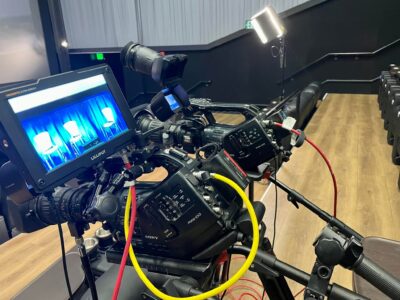Live Video Production
Live video production is an artful blend of technical prowess and creative vision. Our expert team crafts captivating live experiences, seamlessly merging cutting-edge technology with compelling storytelling. Elevate your brand with our dynamic and tailored live video solutions.
Live Video Production
What is Live Video Production?
Live video production is a complex and dynamic process that involves capturing, editing, and broadcasting events or content in real-time. This intricate process requires a combination of technology, creativity, and coordination, and is a vital aspect of numerous industries, ranging from entertainment and sports to business and education.
Unlike pre-recorded content, live production requires managing everything in real-time, from capturing footage to making on-the-spot decisions. This means that the production team must be quick and efficient, as they navigate through the process of delivering a seamless and enjoyable viewing experience.

The Critical Component of Live Video Production
The first critical aspect of producing live video is capturing live events. This involves using cameras, audio equipment, and sometimes drones to capture the action as it happens. The choice of equipment depends on the type of event and the desired visual and auditory effects. Skilled camera operators and technicians collaborate to ensure that the footage is of the highest quality and that all technical aspects, such as lighting and sound, are optimized for the live broadcast.
Audio is an equally important aspect of the production. Clear and crisp sound can enhance the viewer’s experience and is essential for conveying the intended message. To achieve this, high-quality microphones, audio mixing consoles, and other equipment are used to capture and deliver sound in real-time. Audio engineers play a crucial role in ensuring that the audio complements the visual elements seamlessly.

The Transmission to the Content to the Audience
The next phase involves the transmission of the live content to the audience. With advancements in technology, live video can be streamed over the internet in real-time, reaching global audiences instantly. This requires a robust and reliable streaming infrastructure. From satellite links to content delivery networks (CDNs), the choice of transmission method depends on factors like the scale of the audience and the geographical location.
Live video production also entails the integration of graphics and visuals to enhance the overall viewing experience. Graphics may include overlays, lower-thirds, and animations that provide additional information or branding elements. Graphics operators work in tandem with the production team to ensure that these elements are seamlessly integrated into the live feed.
The Distinguishing Feature
One of the distinguishing features of live video production is the need for real-time editing. Unlike pre-recorded content, where post-production allows for meticulous editing, live video production requires editors to make split-second decisions. Live switching between multiple camera angles, adjusting audio levels, and incorporating graphics all happen in real-time, demanding a high level of skill and precision.
Behind the scenes, a director orchestrates the entire production. This individual is responsible for making crucial decisions on the fly, directing camera operators, cueing graphics, and managing the overall flow of the live event. The director’s ability to adapt to unforeseen circumstances is paramount in ensuring a smooth and polished live broadcast.
In the realm of live video production, timing is everything. From the timing of camera cuts to the coordination of live performances, every element must be synchronized seamlessly. This synchronization is often achieved through rehearsals and a well-choreographed production plan.

The Post-Event Phase
Finally, the production is not complete without considering the post-event phase. Depending on the nature of the content, the recorded footage may be repurposed for on-demand viewing or archived for future use. Additionally, analyzing audience engagement, feedback, and viewership metrics provides valuable insights for future productions.

Conclusion
In conclusion, live video production is a captivating blend of art and technology. It requires a skilled and coordinated team working in harmony to bring events to life in real-time. From capturing the action to transmitting it to global audiences, live video production is a testament to the power of seamless collaboration and innovation in the digital age.

